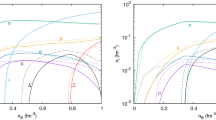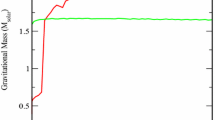Abstract
Neutron stars are among of the most exotic objects in the universe and constitute a unique laboratory to study nuclear matter above the nuclear saturation density. In this work, we study the equation of state (EoS) of the nuclear matter within a relativistic model subject to a strong magnetic field. We then apply this EoS to study and describe some of the physical characteristics of neutron stars, especially the mass–radius relation and chemical compositions. To study the influence of the magnetic field and the hyperons in the stellar interior, we consider altogether four solutions: two different magnetic field to obtain a weak and a strong influence; and two configurations: a family of neutron stars formed only by protons, electrons, and neutrons and a family formed by protons, electrons, neutrons, muons, and hyperons. The limit and the validity of the results found are discussed with some care. In all cases, the particles that constitute the neutron star are in β equilibrium and zero total net charge. Our work indicates that the effect of a strong magnetic field has to be taken into account in the description of magnetars, mainly if we believe that there are hyperons in their interior, in which case the influence of the magnetic field can increase the mass by more than 10 %. We have also seen that although a magnetar can reach 2.48 M ⊙, a natural explanation of why we do not know pulsars with masses above 2.0 M ⊙ arises. We also discuss how the magnetic field affects the strangeness fraction in some standard neutron star masses, and to conclude our paper, we revisit the direct Urca process related to the cooling of the neutron stars and show how it is affected by the hyperons and the magnetic field.








Similar content being viewed by others
Notes
This can be justified since the Fermi temperature of the neutron stars is very high compared to its own temperature [16].
The same holds for the TOV solution showed.
We have named co and bo after their relation with the collapse and the bound state, respectively.
We do not use this modified TOV equations since they imply the existence of a magnetic monopole.
Indeed, the Ξ0 hyperon appears in an insignificant quantity \(Y_{\Xi^{0}} = 10^{-5}\) at 1.2fm − 3.
References
N.K. Glendenning, Compact Stars (Springer, New York, 2000)
S.L. Shapiro, S.A. Teukolsk, Black Holes, White Dwarfs and Neutron Stars (Willey, New Jersey, 1983)
M. Camenzind, Compact Objects in Astrophysics (Springer, Berlin, 2007)
R. Duncan, C. Thompson, Mon. Not. R. Astron. Soc. 275, 255 (1995)
S. Pal, D. Bandyopadhyay, S. Chakrabarty, Phys. Rev. Lett. 78, 2898 (1997)
S. Pal, D. Bandyopadhyay, S. Chakrabarty, J. Phys. G: Nucl. Part. Phys. 25, L117 (1999)
J.M. Lattimer et al., Phys. Rev. Lett. 66, 2701 (1991)
A. Rabhi, C. Providencia, J. Da Providencia, J. Phys. G: Nucl. Part. Phys. 35, 125201 (2008)
A. Broderick, M. Prakash, J.M. Lattimer, Astrophys. J. 537, 351 (2000)
D. Griffiths, Introduction to Elementary Particles (Wiley, Weinheim, 2008)
M.G. Paoli, D.P. Menezes, Eur. Phys. J. A 46, 413 (2010)
N.K. Glendenning, S.A. Moszkowski, Phys. Rev. Lett. 67, 2414 (1991)
A. Rabhi et al., J. Phys. G: Nucl. Part. Phys. 36, 115204 (2009)
K. Huang, Introduction to Statistical Physics (Taylor & Francis, London, 2001)
Q. Peng, H. Tong, Mon. Not. R. Astron. Soc. 378, 159 (2007)
R.R. Silbar, S. Reddy, Am. J. Phys. 72, 7 (2004)
D.P. Menezes et al., Phys. Rev. C 80, 065805 (2009)
J.R. Oppenheimer, G.M. Volkoff, Phys. Rev. 33, 374 (1939)
G. Baym, C. Pethick, P. Sutherland, Astrophys. J. 170, 299 (1971)
A. Rabhi, C. Providencia, J. Phys. G: Nucl. Part. Phys. 37, 075102 (2010)
Xu-Guang Huang et al., Phys. Rev. D 81, 045015 (2010)
M. Malheiro et al., Int. J. Mod. Phys. D 16 489 (2007)
C.E. Rhoades, R. Ruffini, Phys. Rev. Lett. 32, 324 (1974)
P.B. Demorest et al., Nature 467, 1081 (2010)
J. Cottam, F. Paerels, M. Mendez, Nature 420, 51 (2002)
D. Sanwal et al., Astrophys. J. Lett. 574, 61 (2002)
R. Cavagnoli, D.P. Menezes, C. Providencia, Phys. Rev. C. 84, 065810 (2011)
N.K. Glendenning, Astrophys. J. 293, 470 (1985)
Z.X. Ma, Z.G. Dai, T. Lu, Astron. Astrophys. 366, 532 (2001)
J.L. Zdunik et al., Astron. Astrophys. 416, 1013 (2004)
H. Dapo, B.J. Schaefer, J. Wambach, Phys. Rev. C 81, 035803 (2010)
Acknowledgements
This work was partially supported by CNPq and CAPES.
Author information
Authors and Affiliations
Corresponding author
Rights and permissions
About this article
Cite this article
Lopes, L.L., Menezes, D.P. The Influence of Hyperons and Strong Magnetic Field in Neutron Star Properties. Braz J Phys 42, 428–436 (2012). https://doi.org/10.1007/s13538-012-0093-y
Received:
Published:
Issue Date:
DOI: https://doi.org/10.1007/s13538-012-0093-y




